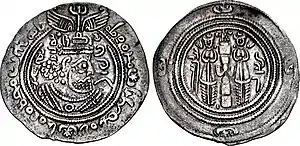Fromo Kesaro
Fromo Kesaro, also Phromo Kesaro (phonetically "Roman Caesar") was a king of the Turk Shahis, a dynasty of Western Turk or mixed Western Turk-Hephthalite origin, who ruled from Kabul and Kapisa to Gandhara in the 7th to 9th centuries.[1] In Chinese sources "Fromo Kesaro" was transcribed "Fulin Jisuo" (拂菻罽娑), "Fulin" (拂菻) being the standard Tang Dynasty name for "Byzantine Empire".[2][3][4]

Kabulistan was the heartland of the Turk Shahi domain, which at times included Zabulistan[5] and Gandhara.
During their rule, the Turk Shahi were in constant conflict against the eastward expansion of the Abbasid Caliphate.[1] Circa 650 CE, the Arabs attacked Shahi territory from the west, and captured Kabul.[1] But the Turk Shahi were able to mount a counter-offensive and repulsed the Arabs, taking back the areas of Kabul and Zabulistan (around Ghazni), as well as the region of Arachosia as far as Kandahar.[1] The Arabs again failed to capture Kabul and Zabulistan in 697-698 CE, and their general Yazid ibn Ziyad was killed in the action.[1]
From 719 CE, Tegin Shah was the king of the Turk Shahis. He then abdicated in 739 CE in favour of his son Fromo Kesaro, probable phonetic transcription of "Caesar of Rome" in honor of "Caesar", the title of the then East Roman Emperor Leo III the Isaurian who had defeated their common enemy the Arabs in 717 CE, and sent an embassy through Central Asia in 719 CE.[1][lower-alpha 1] The Chinese annals record that "In the first month of the seventh year of the period Kaiyuan [719 CE] their Lord [拂菻王, "the King of Fulin"] sent the Ta-shou-ling [an officer of high rank] of T'u-huo-lo 吐火羅, Tokhara (...) to offer lions and ling-yang [antelopes], two of each. A few months after, he further sent Ta-te-seng ["priests of great virtue"] to our court with tribute."[6]
Fromo Kesaro appears to have fought vigorously against the Arabs, and his victories may have forged the Tibetan epic legend of King Phrom Ge-sar.[1]
The Turk Shahis eventually weakened against the Arabs in the late 9th century CE.[1] Kandahar, Kabul and Zabul were lost to the Arabs, while in Gandhara the Hindu Shahi took over. The last Shahi ruler of Kabul, Lagaturman, was deposed by a Brahmin minister, possibly named Vakkadeva,[7][8][9] in c. 850, signaling the end of the Buddhist Turk Shahi dynasty, and the beginning of the Hindu Shahi dynasty of Kabul.[10]
References
- Kim, Hyun Jin. The Huns. Routledge. pp. 58–59. ISBN 978-1-317-34090-4.
- Rahman, Abdur; Bopearachchi (Ed.), Osmund; Boussac (Ed.), Marie-Françoise (2002). Afghanistan. Ancien Carrefour entre l’Est et l’Ouest (New Light on Khingal, Turk and Hindu Shahis) (PDF). XV. Turnhout, Belgium: Brepols. pp. 37–41. ISBN 2-503-51681-5.CS1 maint: extra text: authors list (link)
- Balogh, Dániel. Hunnic Peoples in Central and South Asia: Sources for their Origin and History. Barkhuis. p. 106. ISBN 978-94-93194-01-4.
- Piras, Andrea. "FROMO KESARO. Echi del prestigio di Bisanzio in Asia Centrale, in Polidoro. Studi offerti ad Antonio Carile, a cura di G. Vespignani (Centro italiano di Studi sull'Alto Medioevo), Spoleto 2013, pp. 671-690": 681. Cite journal requires
|journal=(help) - "15. The Rutbils of Zabulistan and the "Emperor of Rome"". Pro.geo.univie.ac.at. Kunsthistorisches Museum Vienna. Retrieved July 22, 2017.
- Old Book of Tang (舊唐書 Jiu Tangshu), ch. 198 (written mid-10th Century C.E.), for 618-906 C.E: "開元七年正月,其主遣吐火羅大首領獻獅子、羚羊各二。不數月,又遣大德僧來朝貢" quoted in English translation in Hirth, F. (1885). China and the Roman Orient: Researches into their Ancient and Mediaeval Relations as Represented in Old Chinese Records. Shanghai & Hong Kong.
- D. W. Macdowall, "The Shahis of Kabul and Gandhara" Numismatic Chronicle, Seventh Series, Vol. III, 1968, pp. 189-224, see extracts in R. T. Mohan, AFGHANISTAN REVISITED … Appendix –B, pp. 164-68
- Raizada Harichand Vaid, Gulshane Mohyali, II, pp. 83 and 183-84.
- H. G. Raverty, Tr. Tabaqat-i-Nasiri of Maulana Minhaj-ud-din, Vol. I, p. 82
- "16. The Hindu Shahis in Kabulistan and Gandhara and the Arab conquest". Pro.geo.univie.ac.at. Kunsthistorisches Museum Vienna. Retrieved July 22, 2017.
Notes
- Martin 2011, p. 127:"He received this laudatory epithet because he, like the Byzantines, was successful at holding back the Muslim conquerors."
Sources
- Martin, Dan (2011). "Greek and Islamic Medicines' Historical Contact with Tibet". In Akasoy, Anna; Burnett, Charles; Yoeli-Tlalim, Ronit (eds.). Islam and Tibet: Interactions Along the Musk Routes. Farnham, Surrey: Ashgate Publishing. pp. 117–144. ISBN 978-0-7546-6956-2.

